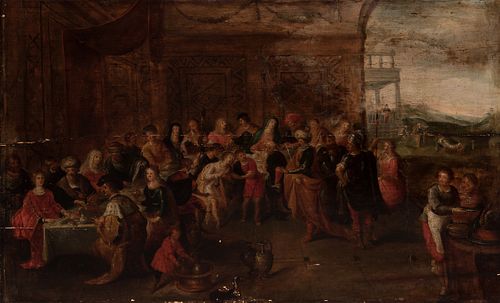FRANS FRANCKEN II (Antwerp, Belgium, 1581 - 1642). "The Wedding at Cana". Oil on oak panel. Cradled
Lot 30
About Seller
Setdart Auction House
Carrer Aragó 346
Barcelona
Spain
Setdart Subastas was born in 2004 and is currently the first online art auction in Spain with solidity, prestige and reliability guaranteed by our more than 60,000 users. Setdart has a young, dynamic and enterprising team ready to successfully manage the purchase and sale of art works through custom...Read more
Estimate:
EUR€7,000 - EUR€9,000
$7,526.88 - $9,677.42
Absentee vs Live bid
Two ways to bid:
- Leave a max absentee bid and the platform will bid on your behalf up to your maximum bid during the live auction.
- Bid live during the auction and your bids will be submitted real-time to the auctioneer.
Bid Increments
| Price | Bid Increment |
|---|---|
| EUR€0 | EUR€10 |
| EUR€200 | EUR€25 |
| EUR€500 | EUR€50 |
| EUR€1,000 | EUR€100 |
| EUR€3,000 | EUR€200 |
| EUR€5,000 | EUR€500 |
| EUR€10,000 | EUR€1,000 |
| EUR€20,000 | EUR€2,000 |
| EUR€50,000 | EUR€5,000 |
About Auction
By Setdart Auction House
Oct 20, 2021
Set Reminder
2021-10-20 07:30:00
2021-10-20 07:30:00
America/New_York
Bidsquare
Bidsquare : OLD MASTERS
https://www.bidsquare.com/auctions/setdart-auction-house/old-masters-7700
Setdart Auction House sofia@setdart.com
Setdart Auction House sofia@setdart.com
- Lot Description
FRANS FRANCKEN II (Antwerp, Belgium, 1581 - 1642). "The Wedding at Cana". Oil on oak panel. Cradled Presents frame following ancient models, repainting, restorations and varnish pasmado. Presents mark on the back of the guild of craftsmen. Size: 71 x 116 cm; 106 x 149 cm (frame). Painting of devotional character collected in the Gospel of St. John (2:1-11). You can see one of the miracles of the life of Jesus. It is the well-known theme of the wedding at Cana, of great importance both in the liturgy and, for this reason, in art, because it is the first moment in which Jesus performs a miracle or sign, thus beginning what is known as his "Public Life". This work stands out in importance, because the figure of Christ cannot be observed, as is usual, but the representation of the Virgin appears in the center of the composition, sharing the table with the rest of the guests. This presence reveals the primordial role of the figure of the Virgin, both in the life of Jesus and in Christianity, since it is she who, in sorrow, tells Christ that the wedding wine has run out and that they will not be able to continue with the celebration. It is at this moment when Jesus, attentive to his mother's words, performs his first miracle. The scene is completed with another image that develops in the right area of the canvas, in it we can see how several men carry a third shrouded man, so it is probably a representation of Lazarus. The piece follows the faithful style of Antwerp painting, where despite the religious theme, anecdotal and everyday elements are introduced, such as the child in the foreground, filling a basin, the dog, or the characters that are in the right area of the composition, away from the rest of the diners. The most fruitful of the Francken family, Frans II, or the Younger, learned from his father, Frans Francken the Elder, whose style he first cultivated. In 1605 he joined the Painters' Guild of St. Luke in Antwerp, thus beginning a career that would last until 1640, in which he specialized in cabinet painting. His contribution to this genre was of great importance, influencing artists such as Teniers. His style is based on that of Jan Brueghel de Velours, although it also shows strong influences of his father and his uncle, Hieronimus Francken. In his early works, debts to Mannerism and 16th century painting can be seen, both in the structure of the compositions and in the rhythm and expression of his figures. They also include evident references to the work of Italian artists such as Raphael, Veronese and Zuccaro. Similarly, the use of prints by Dürer and Lucas of Leyden for some of his figures has been demonstrated. The extensive production of Frans Francken the Younger can be divided into four stages. His youthful works denote his initial link with the themes and styles of the sixteenth century, with high points of view and a clear lack of spatial cohesion. He also uses local colors, especially browns, blues and greens. Characteristic are his figures with large black eyes, achieved through touches of charcoal black, which will continue throughout his career. In a second stage, from 1610 onwards, his palette will become lighter, while he begins to be clearly recognizable for his subjects and interpretations. This is the time of the inclusion of figures, especially stereotyped women that will be repeated throughout his work. In a third period, from 1620, his typical male figures wearing a turban or Phrygian cap begin to appear, while his compositions denote a profoundly eclectic character. The general luminosity now reaches its zenith, determining the chromatic scheme of the work and following in part the general harmonization typical of the Flemish school.
- Shipping Info
-
In-house shipping available. Please inquire at admin@setdart.com.
-
- Buyer's Premium



 EUR
EUR CAD
CAD AUD
AUD GBP
GBP MXN
MXN HKD
HKD CNY
CNY MYR
MYR SEK
SEK SGD
SGD CHF
CHF THB
THB









